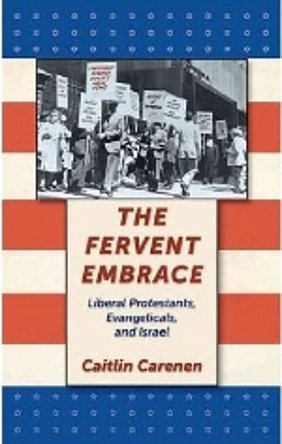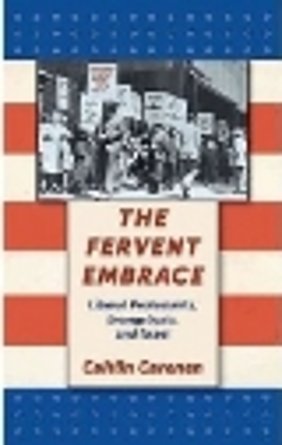Tracing American Protestants’ Multiple Viewpoints on Israel
Using a different scope than other scholars looking at American Protestants and Israel, Caitlin Carenen examines mainline Protestants and evangelical Protestants in the same volume. In so doing, she hopes to correct the misperception that mainline Protestants have been “monolithically antisemitic and anti-Israel” and to add nuance to discussions of evangelicals, whose relationship to the State of Israel has drawn scrutiny because it is, as she aptly puts it, “somewhat sensational” (pp. xv, xiv–xv). She contributes to both religious studies and political science by adding to our knowledge of the role religion played in the formation of U.S. foreign policy toward Israel.
A high point of the book is its contribution to our growing understanding of the idea of the “Judeo-Christian tradition,” a category whose formation has also recently been investigated by Kevin Schultz in Tri-Faith America: How Catholics and Jews Held Postwar America to Its Protestant Promise (2011) and Deborah Dash Moore in GI Jews: How World War II Changed a Generation (2004). Carenen shows that mainline Protestants in the early twentieth century held antisemitic viewpoints, largely rooted in supersessionist theology, yet these attitudes changed as a result of Protestant soul searching in the wake of the Holocaust. By the middle of the twentieth century, many Protestants accepted Jews and supported Israel--the “fervent embrace” of her title--based on “humanitarian and geopolitically pragmatic reasons” (p. xi). That support from influential mainline Protestants was already present, she maintains, when evangelicals started to support Israel in larger numbers for theological reasons.
Carenen does not explicitly define “Zionist,” but I read her implicit definition to be “someone who favors a Jewish state.” To draw out one of the points that Carenen does not make but that can be made based on the material she includes, being opposed to a Jewish state was different from being opposed to Jews immigrating to Palestine. The small group of mainline Protestants who actively opposed Zionism in the 1940s, 1950s, and 1960s, before they were joined by many of their coreligionists after the 1967 war, opposed Zionism for the same reasons Jewish anti-Zionists did. Many of the Protestants Carenen discusses who were anti-Zionist before 1967 were opposed to ethnic nationalism, not a Jewish presence in Palestine. (We could use “political Zionism” to describe the drive for a Jewish state and “cultural Zionism” to refer to supporting Jews’ right to move to Palestine, but here I follow the author’s usage.) On page 33, Carenen discusses the views of both Virginia Gildersleeve, who was Protestant, and Judah Leon Magnes, who was Jewish. Magnes, who was president of the Hebrew University in Jerusalem during the British Mandate period, opposed a Jewish state and promoted the idea of a binational state. He believed that Jews should be able to immigrate to Palestine as a safe haven after the Holocaust. “For Magnes,” Carenen writes, “the most important issue was not Jewish sovereignty in Palestine but rather finding a place of refuge for the persecuted Jews in Europe” (p. 8). In much the same way, Gildersleeve’s Committee for Peace and Justice in the Holy Land was opposed to a Jewish state but not to a Jewish presence: the organization “consistently argued that the only just solution for Palestine would be the creation of a federation governed by both Arabs and Jews” (p. 64). These Protestants who were actively anti-Zionist before 1967 had principled nontheological and not antisemitic reasons for their positions, as did the larger number of Protestants who shifted support from Israel after 1967.
Carenen’s demonstration that many mainline Protestants withdrew support from Israel after the 1967 war is an important corrective for those who might be inclined to think that the reason so many mainline American Protestants are anti-Zionist now is because of historic antisemitism. An ethic based on humanitarian grounds, as mainline Protestants’ support for Israel largely was after they changed their views of Judaism after the Holocaust, is different from unconditional support and could change with changing circumstances. In the wake of the 1967 war, many mainline Protestants shifted their humanitarian support to Palestinians. As observers have noted, evangelical Protestants’ reactions were for the most part much more excited. Overjoyed by Israel’s territorial gains and quick victory, they saw the hand of God at work and their support for Israel increased. They supported Jews because they saw them as actors in the final biblical drama. This means, as has been discussed frequently in the scholarship, that evangelical Christians who support Israel are unlikely to withdraw support no matter what may happen, and in fact may interpret mainline Protestants’ criticisms of Israeli actions as evidence that those who are on God’s side will be attacked by the world. As Carenen points out, in terms of demographics it is now evangelical Christians who are “mainline” in America, with the liberal Protestant denominations continuing to shrink. And yet this is one of the most interesting of the historical lessons I drew from this book: the cavalier Protestant antisemitism she documents in the 1930s all but passed away, so there is no guarantee current evangelical attitudes toward Israel will persist either. Indeed, one change Carenen believes she can discern in the recent past among evangelicals is a shift from “bloody end-times scenarios” that might include horrific scenes of Jews dying in large numbers or, alternatively, converting to Christianity in large numbers, to a more recent focus “on the command to bless Israel in order to garner blessings for the United States” (pp. 211, 210–211). This shift away from end-times talk may actually contain a sprouting seed of humanitarian and pragmatic concern not unlike the previous shift Carenen charts among mainline Protestants and serves as a reminder not to see evangelicals as static or homogeneous, for they are not.
Footnote 6 on pages 213–214 positions this book within the context of other works on this particular subject matter, but a discussion of where Carenen positions herself methodologically is completely absent. This may be a result of editors believing that readers do not want to be bogged down with historiographical details. From my point of view, a commitment to ongoing scholarly conversation requires a foregrounding of that apparatus in the text itself. The book is a history based on periodicals and archive materials, which lends itself to a writing style geared toward other academics even if the editors are hoping to invite a wider audience. Reflection on method might have led to somewhat different terminology that would have strengthened Carenen’s points. Her frequent use of the term “Protestantism” actually works against one of her stated goals: illustrating differences and debates within this category. The writing tends to convey the sense that there was an entity called “mainline Protestantism” and that it did things or thought things, as in the formulation, “After war broke out in September 1939, the main concern of mainline Protestantism centered not upon continuing developments in the Holy Land but on remaining neutral in the European war” (p. 20). At another point, she refers to “American Protestantism’s initial reaction toward Jewish Zionist impulses,” even though her evidence traces the multiple reactions of multiple Protestants (p. 16). Carenen wants us to remember the presence of differences and overcome the tendency to homogenize, so it is unfortunate that her words work against her at some points.
Carenen’s book is particularly welcome as a call for seeing more complexity in the history of American Protestants’ views of Zionism. It also points the way toward studying American Catholics’ views of Zionism. In the final chapter, she mentions that while 57 percent of Protestants considered themselves Christian Zionists in a 1987 study, “only 35 percent of Catholics did” (p. 197). While certainly outside the scope of this work, I hope another scholar will see fit to take up the question of who those 35 percent of Catholics were and what their reasons were for considering themselves Christian Zionists.



